西方翻译理论
PeterNewmark西方翻译理论

二、主要理论
1.语义翻译(semantic translation) 交际翻译(communicative translation)
2.隐喻翻译(metaphor translation)
实用文档
文本 译
抒发功能 信息功能 呼唤功能
关联
翻译法 译
审美功能
应酬功能 元语言实功用文能档
语义翻 交际翻
实用文档
意译 译
理论背景
直译
语义翻译 交际翻
实用文档
the spirit sense message
the letter ---
the words --- the
form
---
实用文档
各种翻译方法的差异:
SL emphasis TL emphasis
Word-for-word translation Adaptation Literal translation Free translation Faithful translation Idiomatic transla实t用i文档on
实用文档
一、生平 二、主要理论
实用文档
一、生平
彼得·纽马克,生于 1916年,是英国著名的翻 译家和翻译理论家。他从 事过多种欧洲语言的翻译 工作,是出色的译者和编 辑。纽马克同时也是一位 语言学家,并担任英国语 言学家协会会长。他的主 要兴趣就是把语言学的相 关理论应用于翻译实践之 中,把翻译研究和英语语 实用文档言研究相结合。
请你念这段剧词的时候,要照我刚才读 给你听的那样子,一个字一个字打舌头上很轻快 地吐出来;要是你也像多数的伶人们一样,只会 拉开喉咙嘶叫,那么,我宁愿叫那宣布告示的公 差念我这几行词句。(朱生豪 译)
第四章 当代西方翻译理论
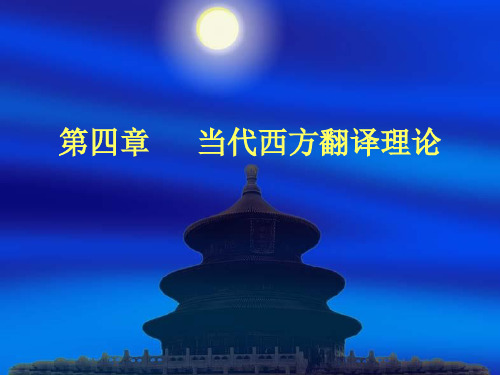
威密尔则突破了对等理论的限制 ,以文本目的(skopos)为翻译过程的第 一准则 ,发展了功能派的主要理论:目的论(skopos theory) 。威密尔所提 出的目的论(skopos theory)是功能派翻译理论中最重要的理论。skopos 是希腊词 ,意思是 “目的” 。根据目的论 ,所有翻译遵循的首要法则 就是 “目的法则” :翻译行为所要达到的目的决定整个翻译行为的过 程 ,即结果决定方法。这个目的有三种解释:译者的目的;译文的交际 目的;和使用某种特殊翻译手段所要达到的目的。通常情况下 , “目的” 是指译文的交际目的。
德国功能主义流派
二十世纪七十年代 ,德国出现一派翻译理论 — —功能派翻
译理论。功能派认为翻译(包括口、 笔译)是一种行为。其 理论的重点表现在三方面: (1)对翻译实质的阐释(2)对翻译 过程参与者的角色分析(3)功能翻译原则的提出。
谈到功能派,就不得不提及三位功能派翻译理论杰出的贡献
20世纪20年代起,前苏联的文学翻译得到发展的同时,翻
译研究也得到长足的进展。其最大特点就是一开始就和文 学翻译紧密联系在一起,但这时还是注重翻译作品的艺术 性。文艺学派开始于当时的俄国形式主义,代表人物为蒂 尼亚诺夫。
楚柯夫斯基的《崇高的艺术》一书问世后,被视为前苏联
译坛文艺学派的代表作之一,此书立足于大量丰富的翻译 实践,探讨了使翻译作品成为真正的艺术作品的途径。
纽马克在《翻译问题探讨》出版,立刻引起广泛赞誉。正
是在这本书中,他提出了“语义翻译”和交际翻译的概念。 此后,分别于1993年何1995年,又出版了《翻译短评》 (Paragraphs on Translation)和《翻译短评(第二集)》 (More paragraphs on Translation)。 翻译试图在译人语的语义和句法结构允许的范围内传达原 著的确切上下文意义。交际翻译试图对译文读者产生一种 效果 ,这效果要尽可能接近原文对读者所产生的效果。 语义翻译的服务对象是原语作者,交际翻译服务的对象是 译入语的读者 。这两种方法的一个根本区别在于:当出现 矛盾时,交际翻译必须强调“ 表现力” ,而不强调信息 的内容。
西方翻译理论简介
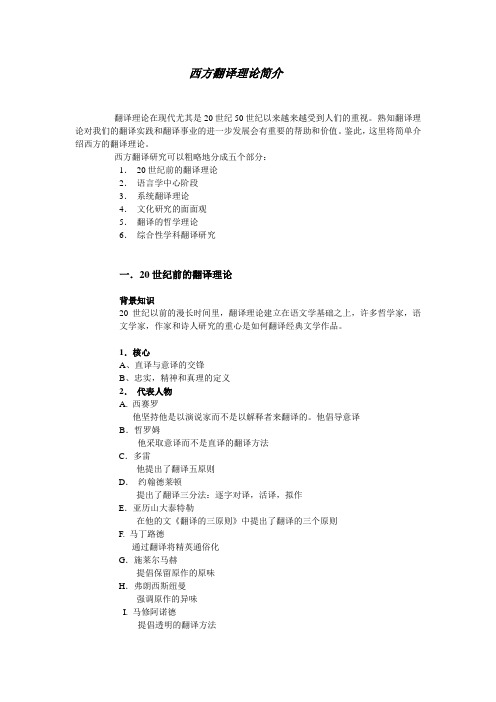
西方翻译理论简介翻译理论在现代尤其是20世纪50世纪以来越来越受到人们的重视。
熟知翻译理论对我们的翻译实践和翻译事业的进一步发展会有重要的帮助和价值。
鉴此,这里将简单介绍西方的翻译理论。
西方翻译研究可以粗略地分成五个部分:1.20世纪前的翻译理论2.语言学中心阶段3.系统翻译理论4.文化研究的面面观5.翻译的哲学理论6.综合性学科翻译研究一.20世纪前的翻译理论背景知识20世纪以前的漫长时间里,翻译理论建立在语文学基础之上,许多哲学家,语文学家,作家和诗人研究的重心是如何翻译经典文学作品。
1.核心A、直译与意译的交锋B、忠实,精神和真理的定义2.代表人物A. 西赛罗他坚持他是以演说家而不是以解释者来翻译的。
他倡导意译B.哲罗姆他采取意译而不是直译的翻译方法C.多雷他提出了翻译五原则D.约翰德莱顿提出了翻译三分法:逐字对译,活译,拟作E.亚历山大泰特勒在他的文《翻译的三原则》中提出了翻译的三个原则F. 马丁路德通过翻译将精英通俗化G.施莱尔马赫提倡保留原作的原味H.弗朗西斯纽曼强调原作的异味I. 马修阿诺德提倡透明的翻译方法二.语言学中心阶段背景知识在20世纪初,索绪尔提出了普遍语言学理论,既为语言学提供了基础,也促使了翻译的语言学研究的建立。
韩礼德的系统功能语言学,布卢姆菲尔德的结构语言学及乔姆斯基的转换生成语法都为翻译理论家进行语言学方向的翻译研究提供了基础。
主要理论1:对等和等效(1950s-1960s)1.代表人物(1)罗曼雅各布逊A.描写了翻译的三类型:语内翻译,语际翻译和符际翻译B.提出语际翻译指用一种语言替换另一种语言种的整个信息C.强调对等的差异性(2)尤金奈达A.提出形式对等和动态对等B.提出著名的读者反应理论C.他的理论以乔姆斯基的转换生成语法为基础(3)皮特纽马克A.提出语义对等和交际对等(4)韦内科勒A.区分了对应和对等B.描写了五种对等:外延意义,隐含意义,文本规则,语用及形式对等主要理论2:翻译级转换理论(1950s-1970s)1.翻译级转换:将原语翻译到目的语过程中发生的语言方面的小改变。
《西方翻译理论简介》课件

翻译科学之父切斯特曼
总结词
翻译科学派创始人
详细描述
切斯特曼是翻译科学派的创始人,他主张将 翻译研究建立在科学的基础上,提出了翻译 的“五步骤”理论,即分析、转换、重构、 验证和接受。切斯特曼的翻译理论强调了翻 译的科学性和客观性,对后来的翻译研究产 生了重要影响。
翻译等值论者尤金·奈达
总结词
功能对等理论创始人
诸如许渊冲、杨宪益等,都是文学翻译领域的杰出代表。
商务翻译
商务翻译
商务翻译是指将商务文件、合同 、协议等从一种语言转换成另一 种语言的过程。商务翻译要求翻 译者具备专业的商务知识和语言
表达能力。
翻译要点
商务翻译的要点是准确、专业、 严谨,确保译文在商务场合中能
够被准确理解和使用。
实际应用
商务翻译在实际应用中非常重要 ,例如国际贸易、投资、法律等
01
西方翻译理论的挑 战与未来发展
文化差异与翻译的挑战
语言与文化差异
翻译过程中,语言和文化差异是最大的挑战之一。译者在 翻译过程中需要充分理解源语言和目标语言的文化背景, 确保信息的准确传递。
文化意象的传递
在翻译过程中,如何准确传递原文中的文化意象是一个重 要的问题。译者需要充分了解两种文化,避免因文化差异 造成的误解和歧义。
01
强调译本的功能和目的,关注译本在目标文化中的接受度。
多元化翻译理论的涌现
02
包括后殖民主义翻译理论、女性主义翻译理论等,关注译本与
权力、性别等议题的关系。
翻译与跨文化交际的结合
ห้องสมุดไป่ตู้
03
强调译本在跨文化交际中的作用,关注文化差异的处理和传递
。
01
西方翻译理论的主 要流派
第四章 当代西方翻译理论
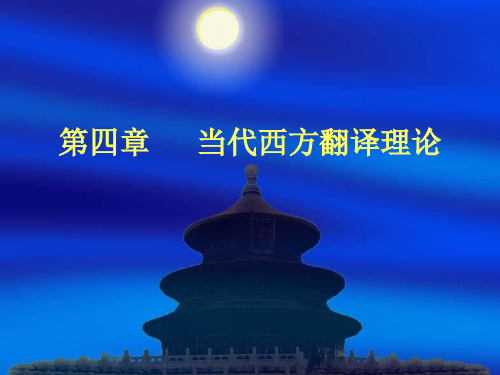
第四章
当代西方翻译理论
英国翻译学家纽马克将西方研究翻译的历史划分为两大时
期:从公元前55年到20世纪上半叶属于语言学前时期, 20世纪下半叶则属语言学时期。美国语言学家兼圣经翻译 家奈达则认为西方的翻译理论有四大流派:语文学派、语 言学派、交际学派和社会符号学派。语言学前时期主要翻 译圣经和文学作品,翻译主要是少数人的事,这个时期的 翻译理论就是奈达所说的语文学派的理论。后三种理论流 派即纽马克所说的语言学时期的翻译理论。
Байду номын сангаас
他们都把文学理解成为一个综合体,一个动态的体系;他们都认为, 翻译研究的理论模式与具体的翻译研究应互相借鉴;他们对文学翻译 的研究都属于描述性的,重点放在翻译的结果、功能和体系;他们都 对制约和决定翻译成果和翻译接受的因素、对翻译和各种译本类型指 间的关系、翻译在特定民族或国别文学内的地位和作用以及翻译对民 族文学间的相互影响所起的作用感兴趣。
1959 年, 雅可布逊发表了题为《论翻译的语言学问题》
( On Linguistic Aspects of Translation) 的论文,从语言学和符 号学的角度, 对语言和翻译、 翻译的重要性及普遍性的问 题作了精辟的论述。
西方翻译理论

西方翻译理论西方翻译理论简介中西译论因其不同的哲学思想、价值观念和语言文化习惯形成了彼此相异的译论体系。
西方翻译理论有着严格的方法论、精确的理论描述、细腻和定性定量的分析。
战后西方翻译研究更是欣欣向荣,翻译流派异彩纷呈,翻译大家层出不穷,翻译思想、翻译方法、研究角度日新月异。
译介和引进当代西方翻译理论的成果,加强中西译论的交流与对话,无疑对创立具有中国特色的翻译研究大有裨益。
正如奈达所说,翻译理论应“兼容并包,利用多种手段来解决翻译中的种种难题”。
积极地了解当代西方翻译理论的沿革、现状与发展趋势,打破翻译研究的地域、学科、流派的限制,形成跨学科综合、多元互补的研究格局,汲取一切译论的研究成果,这无论对初涉译事的后生或对有相当经验的译者应该说都不无裨益。
西方翻译理论也包括古典译论、现代译论、当代译论,尤其是当代西方翻译理论更是流派林立,如美国翻译培训派:策德内斯:创立培训班的前提、里查兹:翻译的理论基础、庞德:细节翻译理论、威尔:翻译的矛盾;翻译科学派:乔姆斯基:语言的“内在”结构、奈达:翻译中的生成语法、威尔斯:翻译的科学、德国翻译理论的发展趋势;早期翻译研究派:俄国形式主义的影响、利维.米科和波波维奇、霍姆斯、勒非弗尔、布罗克与巴斯奈特;多元体系派:传统语言学和文学界限的瓦解、通加诺夫:文学的演变、佐哈尔:系统内部文学的联系、图里:目标系统;解构主义派:福科:解构原文、海德格尔:重新认识命名、德里达:系统的解构主义理论、解构主义理论的影响、解构与创译。
当代西方翻译理论大家包括奈达(三个发展阶段、对等概念、逆转换理论)、卡特福德(翻译的语言学、翻译的界定与分类、翻译等值的条件与可译性)、威尔斯(翻译是一门科学、翻译是交际过程、翻译方法的定义与分类、文本类型与翻译原则)、纽马克(语义结构、翻译原则、文本类型与翻译方法)、斯坦纳(翻译是理解的过程、语言的可译性、翻译的步骤)、巴尔胡达罗夫(翻译的定义及实质、翻译理论的定位、语义与翻译、翻译的层次)、费道罗夫、,.科米萨罗夫的翻译理论、穆南(语言与意义、“世界映象”理论与可译性、意义交流与翻译、可译性与限度)、塞莱丝柯维奇和法国释意理论(释意的基本问题、翻译程序与评价标准、释意理论与翻译教学)。
西方翻译理论
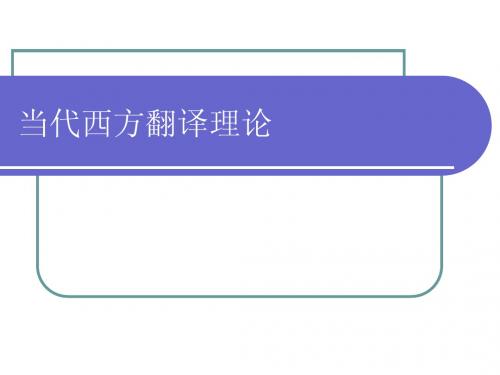
罗曼.雅科布逊Roman Jakobson
原籍俄国,后移居捷克;二战时迁至美国, 加入美籍。作为学派的创始人之一,他对 翻译理论的贡献主要体现在《论翻译的语 言学问题》(On Linguistic Aspects of Translation)之中。文章从语言学的角度, 对语言和翻译的关系、翻译的重要性、以 及翻译中存在的问题作出了详尽的分析和 论述。自1959年发表后,此文一直被 西方理论界奉为翻译研究的经典之一。
尤金.奈达Eugene Nida
因此,如按照英汉两种语言字面上的对等来翻译, 原句译为“他靠传染来思维,象感冒一样获得思 想”,这样,原文的真正意义就无法清楚地表达。 事实上,在汉语中很难找到一个完全与英文对等 的句型来表达同样的内涵。于是,译者将源语的 深层结构转换成目的语的表层结构,即用目的语 中相应的词汇直接说明、解释原文的内涵,以使 译文读者更易接受译作。根据奈达的翻译理论, 文化差异的处理是与从语义到文体将源语再现 于目的语紧密相联的。只有当译文从语言形式 到文化内涵都再现了源语的风格和精神时,60、70年代,德国译学界受结构主义语言 学的影响,形成了以纽伯特(A. Neubert)、卡德 (O. Kade)维代表的莱比锡派(the Leipzig School) 和以威尔斯(W. Wilss)为代表的萨尔派 (Saarbrücken School)。前者立足于转换生成语 法,在翻译中严格区分不变的认知因素与可变的 语用因素;后者是奈达学说的追随者,主张建立 翻译科学。 功能派翻译理论在这时兴起,针对翻译语言学派 中的薄弱环节,广泛借鉴交际理论、行动理论、 信息论、语篇语言学和接受美学的思想,将研究 的视线从源语文本转向目标文本。目的论影响深 远,功能学派因此有时也被称为目的学派。
西方翻译理论史
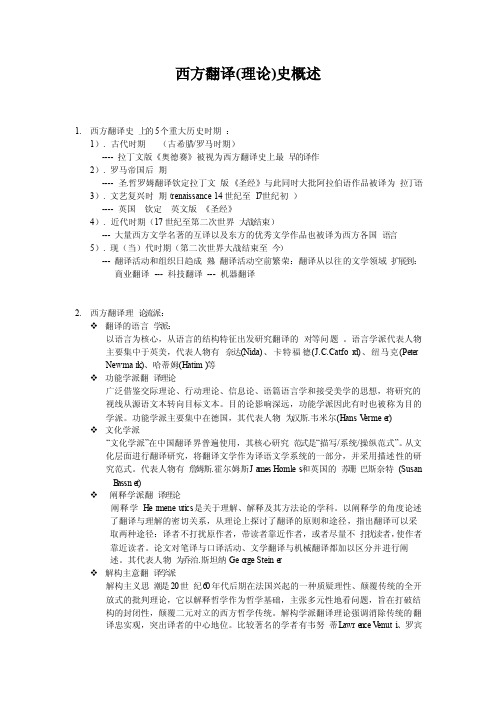
西方翻译(理论)史概述1.西方翻译史上的5个重大历史时期:1). 古代时期(古希腊/罗马时期)---- 拉丁文版《奥德赛》被视为西方翻译史上最早的译作2). 罗马帝国后期---- 圣.哲罗姆翻译钦定拉丁文版《圣经》与此同时大批阿拉伯语作品被译为拉丁语3). 文艺复兴时期(renais sance 14世纪至17世纪初)---- 英国钦定英文版《圣经》4). 近代时期(17世纪至第二次世界大战结束)--- 大量西方文学名著的互译以及东方的优秀文学作品也被译为西方各国语言5). 现(当)代时期(第二次世界大战结束至今)--- 翻译活动和组织日趋成熟。
翻译活动空前繁荣:翻译从以往的文学领域扩展到:商业翻译--- 科技翻译--- 机器翻译2.西方翻译理论流派:翻译的语言学派:以语言为核心,从语言的结构特征出发研究翻译的对等问题。
语言学派代表人物主要集中于英美,代表人物有奈达(Nida)、卡特福德(J.C.Catford)、纽马克(PeterNewmark)、哈蒂姆(Hatim)等功能学派翻译理论广泛借鉴交际理论、行动理论、信息论、语篇语言学和接受美学的思想,将研究的视线从源语文本转向目标文本。
目的论影响深远,功能学派因此有时也被称为目的学派。
功能学派主要集中在德国,其代表人物为汉斯.韦米尔(Hans V ermee r) 文化学派“文化学派”在中国翻译界普遍使用,其核心研究范式是“描写/系统/操纵范式”。
从文化层面进行翻译研究,将翻译文学作为译语文学系统的一部分,并采用描述性的研究范式。
代表人物有詹姆斯.霍尔姆斯Ja mes Homles和英国的苏珊巴斯奈特(Susan B assne t)阐释学派翻译理论阐释学Hermeneu ti cs是关于理解、解释及其方法论的学科。
西方翻译理论简介

05
西方翻译理论的应用领域
文学翻译
文学翻译的特点
文学翻译具有艺术性和创造性, 要求翻译者具备扎实的语言功底 、广博的文化知识和较高的审美 情趣,能够准确传达原文的情感
和风格。
文学翻译的难点
文学翻译的难点在于如何处理语 言的韵律、修辞、意象和象征等 方面,要求翻译者具备较高的语
言转换能力和文化素养。
翻译的定义与分类
翻译的定义
翻译是指将一种语言中的文本 或思想以另一种语言的形式进 行再现的过程。
翻译涉及对原语言的理解、表 达和传达,以及在目标语言中 构建相应的语义和语境。
翻译旨在促进不同语言和文化 之间的交流和理解。
翻译的分类
01
02
03
文学翻译
涉及文学作品、散文、诗 歌等文学作品的翻译。
非文学翻译
日期:
西方翻译理论简介
汇报人:
目录
• 西方翻译理论的历史与发展 • 翻译的定义与分类 • 西方翻译理论的核心概念 • 西方翻译理论的主要流派 • 西方翻译理论的应用领域 • 西方翻译理论面临的挑战与发展趋势
01
西方翻译理论的历史与发展
翻译理论的起源
古希腊罗马时期
翻译理论起源于古希腊罗马时期 ,当时的翻译家提出“字面翻译 ”和“精神翻译”两种方法。
Investment Agreement》、《Sales Contract》等,都是西方翻译理
论在商务翻译领域的经典案例。
口译
口译的特点
口译具有即时性和交互性,要求翻译者具备扎实的语言功 底、敏捷的思维和良好的心理素质,能够准确传达说话人 的意思并促进双方交流。
口译的难点
口译的难点在于如何处理语言的口语化表达、口音和语速 等方面,要求翻译者具备较高的语言转换能力和快速反应 能力。
西方翻译理论
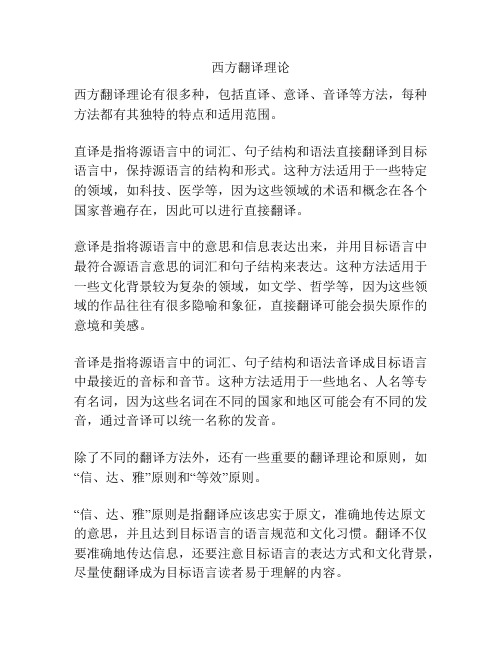
西方翻译理论西方翻译理论有很多种,包括直译、意译、音译等方法,每种方法都有其独特的特点和适用范围。
直译是指将源语言中的词汇、句子结构和语法直接翻译到目标语言中,保持源语言的结构和形式。
这种方法适用于一些特定的领域,如科技、医学等,因为这些领域的术语和概念在各个国家普遍存在,因此可以进行直接翻译。
意译是指将源语言中的意思和信息表达出来,并用目标语言中最符合源语言意思的词汇和句子结构来表达。
这种方法适用于一些文化背景较为复杂的领域,如文学、哲学等,因为这些领域的作品往往有很多隐喻和象征,直接翻译可能会损失原作的意境和美感。
音译是指将源语言中的词汇、句子结构和语法音译成目标语言中最接近的音标和音节。
这种方法适用于一些地名、人名等专有名词,因为这些名词在不同的国家和地区可能会有不同的发音,通过音译可以统一名称的发音。
除了不同的翻译方法外,还有一些重要的翻译理论和原则,如“信、达、雅”原则和“等效”原则。
“信、达、雅”原则是指翻译应该忠实于原文,准确地传达原文的意思,并且达到目标语言的语言规范和文化习惯。
翻译不仅要准确地传达信息,还要注意目标语言的表达方式和文化背景,尽量使翻译成为目标语言读者易于理解的内容。
“等效”原则是指翻译应该追求源语言和目标语言的表达效果和交际效果的一致性。
翻译不是简单地将源语言换成目标语言,而是要在保持原文意思的基础上,使翻译成为目标语言读者能够接受和理解的内容。
总的来说,西方翻译理论强调翻译的准确性、忠实性和可读性。
翻译不仅仅是一种语言转换的过程,更是一种文化交流和理解的方式。
只有深入理解源语言和目标语言的文化差异,才能做到准确地传达信息,并且使翻译成为目标语言读者能够理解和接受的内容。
西方翻译理论
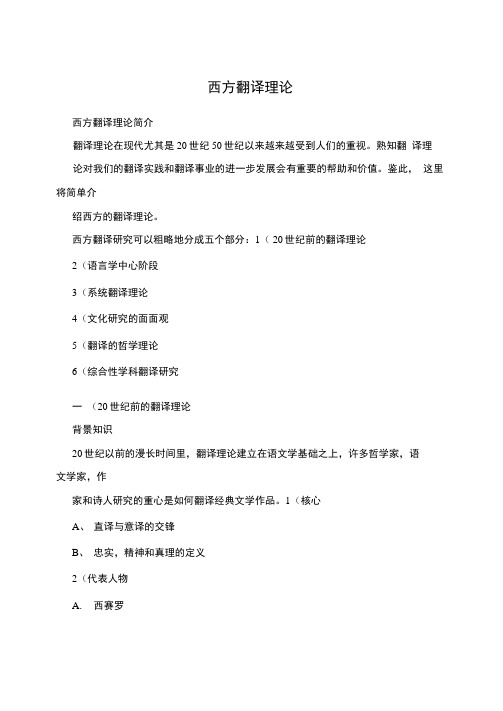
西方翻译理论西方翻译理论简介翻译理论在现代尤其是20世纪50世纪以来越来越受到人们的重视。
熟知翻译理论对我们的翻译实践和翻译事业的进一步发展会有重要的帮助和价值。
鉴此,这里将简单介绍西方的翻译理论。
西方翻译研究可以粗略地分成五个部分:1( 20世纪前的翻译理论2(语言学中心阶段3(系统翻译理论4(文化研究的面面观5(翻译的哲学理论6(综合性学科翻译研究一(20世纪前的翻译理论背景知识20世纪以前的漫长时间里,翻译理论建立在语文学基础之上,许多哲学家,语文学家,作家和诗人研究的重心是如何翻译经典文学作品。
1(核心A、直译与意译的交锋B、忠实,精神和真理的定义2(代表人物A.西赛罗他坚持他是以演说家而不是以解释者来翻译的。
他倡导意译B(哲罗姆他采取意译而不是直译的翻译方法C(多雷他提出了翻译五原则D(约翰德莱顿提出了翻译三分法:逐字对译,活译,拟作E(亚历山大泰特勒在他的文《翻译的三原则》中提出了翻译的三个原则F.马丁路德通过翻译将精英通俗化G(施莱尔马赫提倡保留原作的原味H(弗朗西斯纽曼强调原作的异味I.马修阿诺德提倡透明的翻译方法二(语言学中心阶段背景知识在20世纪初,索绪尔提出了普遍语言学理论,既为语言学提供了基础,也促使了翻译的语言学研究的建立。
韩礼德的系统功能语言学,布卢姆菲尔德的结构语言学及乔姆斯基的转换生成语法都为翻译理论家进行语言学方向的翻译研究提供了基础。
主要理论1:对等和等效(1950s, 1960s)1(代表人物(1)罗曼雅各布逊A(描写了翻译的三类型:语内翻译,语际翻译和符际翻译B(提出语际翻译指用一种语言替换另一种语言种的整个信息C(强调对等的差异性(2)尤金奈达A.提出形式对等和动态对等B.提出著名的读者反应理论C.他的理论以姆斯基的转换生成语法为基础(3)皮特纽马克A(提出语义对等和交际对等(4)韦内科勒A(区分了对应和对等B(描写了五种对等:外延意义,隐含意义,文本规则,语用及形式对等主要理论2:翻译级转换理论(1950s, 1970s)1(翻译级转换:将原语翻译到LI的语过程中发生的语言方面的小改变。
西方翻译理论流派
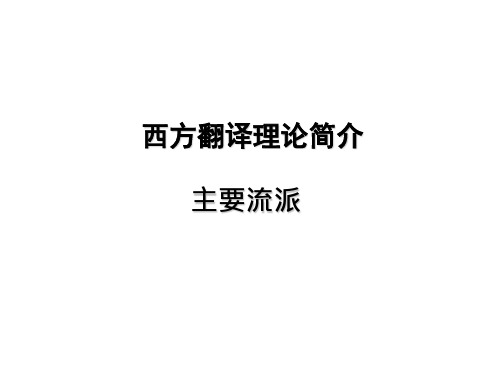
5、关联翻译法:原作或译语文本的语言越重要,就越要紧贴原文翻译。
6、翻译批评:就翻译批评的目的、标准、步骤与方法提出见解,见《翻译入门》、《翻译教程》。
(三)交际理论派与奈达
奈达(Nida) ◆ 语言学派最重要的代表人物之一,著述极丰,其理论对西方当代翻译研究作出了很大的贡献。
• 伦敦学派从社会学角度研究语言。认为语言的意义是由言语使用的社会环境所决定的。语义 理论不仅要规定语法范畴和语法关系,而且要说明文化环境对语义情景的影响。该派观点反 映到翻译领域,即译文的选词是否与原文等同,必须看它是否用于相同的言语环境中。
• 卡特福德 (Catford):著有《翻译的语言学理论》,从翻译性质、类别、对等、转换、限度等 方面着重阐述了“什么是翻译”这一中心问题。
◆ 翻译理论和思想主要见于《论翻译的原则》一书。该书是西方翻译理论的 第一部专著。
◆ 优秀的译作必须使读者领略原作的优点,并得到“同样强烈的感受” 。
◆ 翻译三原则: ◆ 1、译作应完全复写出原作的思想; ◆ 2、译作的风格和手法和原作属于同一性质; ◆ 3、译作应具备原作所具有的通顺。
二、 翻译的语言学派
4、首次提出对等概念,准确的翻译取决于信息对称。翻译所涉及的是两种不同语符中的对等信息。
5、所有语言都具有同等表达能力。如果语言中出现词汇不足,可通过借词、造词或释义等方法对 语言进行处理。
6、语法范畴是翻译中最复杂的问题。这对于存在时态、性、数等语法形式变化的语言,尤其复杂。
(二)伦敦学派与卡特福德和纽马克
• 纽马克(Peter Newmark) 1、从语言意义入手,将翻译定义为:把一种语言中某一语言单位或片段,即文本或文本的一部分
西方翻译理论

功能学派翻译理论
20世纪60、70年代,德国译学界受构造主义语言 学旳影响,形成了以纽伯特(A. Neubert)、卡德 (O. Kade)维代表旳莱比锡派(the Leipzig School) 和以威尔斯(W. Wilss)为代表旳萨尔派 (Saarbrücken School)。前者立足于转换生成语 法,在翻译中严格区别不变旳认知原因与可变旳 语用原因;后者是奈达学说旳追随者,主张建立 翻译科学。
奈达理论旳关键概念是“功能对等”。所谓“功能对 等”,就是说翻译时不求文字表面旳死板相应,而要在 两种语言间达成功能上旳对等。
尤金.奈达Eugene Nida
为使源语和目旳语旳之间旳转换有一种原则,降低差别,尤 金·A·奈达从语言学旳角度出发,根据翻译旳本质,提出了著名 旳“动态对等”翻译理论,即“功能对等”。在这一理论中, 他指出“翻译是用最恰当、自然和对等旳语言从语义到文 体再现源语旳信息”(郭建中,2023 , P65) 。
在这本书中,莱斯把功能范围引入翻译批评,将 语言功能、语篇类型和翻译策略相联络,发展了 以源文与译文功能关系为基础旳翻译批评模式, 从而提出了功能派理论思想旳雏形。她以为理想 旳翻译应该在概念性内容、语言形式和交际功能 方面都与原文对等,并把这么旳翻译称为综合性 交际翻译(integral communicative performance)。 然而在实践中,她又意识到等值不但不可能实现, 而且有时并非是人们所期望旳,所以应该优先考 虑译本旳功能特征而不是对等原则。
到了中世纪,阐释学成为《圣经》研究旳一种分支,经 过对宗教典籍旳注释、阐明向人们澄清上帝旳意图。
文艺复兴和宗教改革时期,阐释学旳研究领域不再拘泥 于宗教经典,而是扩大到对整个古代文化经典旳阐释。 这一时期能够被看做古典阐释课时期。
西方翻译理论书目简介

西方翻译理论经典一、英国部分:1.乔治·坎贝尔(George Campbell, 1719-1796 ),《四福音的翻译与评注》(A Translation of the Four Gospels with Notes, 1789)简介:坎贝尔的《四福音的翻译与评注》是西方最早的翻译专论之一,其理论意义体现在:第一,该论著的问世,标志着西方宗教翻译研究的重大转折。
坎贝尔认为,《圣经》翻译“应为文学和宗教两种不同的目的服务”,这就弥合了哲罗姆提出的“宗教翻译”和“文学翻译”的严格区分,因而具有划时代的重要意义。
第二,该论著是最早论及“对等翻译”的翻译理论专著之一。
坎贝尔在该论著中提出了从词汇、语法和风格方面取得对等的观点,成为20世纪“对等”理论的先导。
第三,该论著的问世,意味着翻译理论的探究突破了前人圄于具体文本的界限,标志着系统性、原则性和抽象性的理论研究视角的出现。
第四,该论著的问世,标志着认知视角的革命性嬗变。
宗教翻译“三原则”的出现,意味着坎贝尔背离了斐洛、奥古斯丁等人所信守的“上帝感召”的无端依从,完全从理性认知的角度提出了宗教翻译“三原则”。
因此,在相同的人文主义文化背景下,其“三原则”的具体内容同泰特勒的“三原则”有着惊人的雷同,实不足为怪。
总之,坎贝尔的“三原则”同泰特勒的“三原则”一样,都具有划时代的重大意义,而且二者相映成趣,相得益彰,不可偏废。
2.亚历山大·弗雷瑟·泰特勒(Alexander Fraser Tytler, 1747-1814),《论翻译的原则》(Essay on the Principles of Translation, 1790)简介:泰特勒的《论翻译的原则》一书是西方翻译理论史上的重要里程碑。
其理论意义表现在:第一,泰特勒首次以概念的形式规定了“优秀翻译”的内涵。
优秀翻译定义出现,标志着泰特勒的译学主体视角具备了“逻各斯中心主义”的特征。
西方翻译理论流派

03
西蒙认为,翻译不仅是一种语言转换 活动,更是一种文化政治行为。因此 ,她主张在翻译中要考虑文化、政治 和社会背景,以及不同语言之间的差 异和共性。同时,她还倡导一种“文 化间性”的翻译策略,即尊重不同文 化之间的差异和多样性,并通过翻译 来促进文化交流和融合。
07
总结与展望
各流派之间的比较与融合
05
解构主义学派翻译理论
解构主义学派概述
01
解构主义学派起源于20世纪60年代的法国,是后结构主义的 重要组成部分。
02
该学派主张对文本进行深入的解读和分析,揭示文本内在的 复杂性和矛盾性。
03
解构主义翻译理论强调翻译的多元性和不确定性,认为翻译 是一种创造性的重写过程。
雅克·德里达的解构主义翻译观
主要观点
文化学派认为翻译不仅仅是语言之间的转换,更 是一种文化现象,涉及到源语文化和目标语文化 之间的互动和交流。
研究方法
文化学派采用描述性研究方法,关注翻译作品在 目标文化中的接受和影响,以及翻译过程中的文 化因素。
安德烈·勒菲弗尔的改写理论
理论框架
勒菲弗尔的改写理论认为翻 译是一种文化改写行为,受 到意识形态、诗学和赞助人 等多种因素的影响。
01
雅克·德里达(Jacques Derrida)是解构主义的代表人物之一,他的 翻译观对解构主义翻译理论产生了深远影响。
02
德里达认为,翻译是一种“延异”(différance)的过程,即语言在 时间和空间上的差异和变化。
03
他主张打破原文和译文之间的二元对立,强调译文的独立性和创造性。
04
德里达的解构主义翻译观为翻译研究提供了新的视角和方法,推动了 翻译理论的多元化发展。
西方翻译理论概述

04
西方翻译理论的应用与实践
文学翻译
01
02
03
文学翻译注重传达原作的艺术风 格和语言魅力,强调译文的流畅 性和可读性。
文学翻译要求译者具备较高的语 言素养和审美能力,能够准确传 达原作的情感和意境。
文学翻译的难点在于处理语言的 艺术性和文化差异,需要译者在 保持原作风格的基础上进行适当 的创新和调整。
翻译的忠实性
忠实性是指译本应忠实于原文本的信息和意图,尽可能地传递原文本的内 容和意义。
忠实性的实现需要译者对原文本进行深入理解和分析,同时还需要考虑目 标读者的文化背景和阅读习惯等因素。
忠实性的重要性在于它保证了翻译的准确性和可靠性,使得读者能够通过 译本获得与原文本尽可能一致的信息和感受。
翻译的创造性
跨学科研究
近现代的翻译理论研究开始关注跨学科的研究,将翻译学与其他学科如语言学、 文学、文化学等结合起来,拓展了翻译研究的领域和视野。
02
西方翻译理论的主要流派
语言学派
代表人物:尤金·奈达
1
2
核心观点:翻译的本质是传达意义,而非语言形 式的对应。强调翻译过程中对等词汇的重要性, 注重语言结构和语义分析。
3
主要贡献:提出动态对等理论,为翻译理论和实 践提供了重要指导。
文学学派
代表人物
01
乔治·斯坦纳、赫尔曼·施尔玛赫等
核心观点
02
翻译不仅仅是语言转换,更是文化和文学的再创造。强调对原
作的理解和表达,以及译者的主体性。
主要贡献
03
推动了对文学翻译的深入研究,丰富了翻译理论。
文化学派
代表人物
01 苏珊·巴斯奈特、安德烈·勒菲弗尔等
文化交流的促进
西方翻译理论
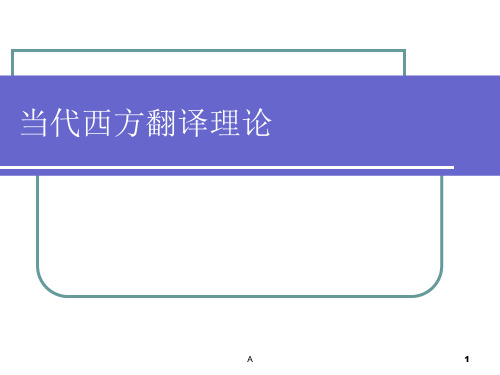
A
11
尤金.奈达Eugene Nida
第三,如果形式的改变仍然不足以表达原文的语 义和文化,可以采用“重创”这一翻译技巧来解 决文化差异,使源语和目的语达到意义上的对等。
“重创”是指将源语的深层结构转换成目的语 的表层结构(郭建中,2000 , P67) ,也就是将源语
文章的文化内涵用译语的词汇来阐述和说明。 例如:“He thinks by infection , catching an opinion likea cold. ”“人家怎么想他就怎么想,就 像人家得了伤风,他就染上感冒。”(刘宓 庆,1998 ,P122)在此句的英文原文中,原文的内 涵并不是靠词汇的表面意义表达出来的,而是隐 藏在字里行间里。
A
14
阐释学派翻译理论
阐释学Hermeneutics是关于理解、解释及其方法论的学 科,它的历史悠久,可以追溯到古希腊。在希腊神话中, 赫尔墨斯(Hermes)是负责解释、翻译神旨、传达神谕的 使者。
古希腊时期的阐释学主要用于逻辑学和辩论术以及一些 宗教、文学经典著作的解释,其目的不外乎消除文本的 歧义和误解。
A
17
功能学派翻译理论
20世纪60、70年代,德国译学界受结构主义语言 学的影响,形成了以纽伯特(A. Neubert)、卡德 (O. Kade)维代表的莱比锡派(the Leipzig School) 和以威尔斯(W. Wilss)为代表的萨尔派 (Saarbrücken School)。前者立足于转换生成语 法,在翻译中严格区分不变的认知因素与可变的 语用因素;后者是奈达学说的追随者,主张建立 翻译科学。
20世纪初,索绪尔提出普通语言学理论,标志 这现代语言学的诞生,也为当代翻译研究的各 种语言学方法奠定了基础。
[文学]第五讲:西方翻译理论
![[文学]第五讲:西方翻译理论](https://img.taocdn.com/s3/m/f06bb59269dc5022aaea00b6.png)
解构主意翻译学派
解构主义思潮是20世纪60年代后期在法国兴起的
一种质疑理性、颠覆传统的全开放式的批判 理论,它以解释哲学作为哲学基础,主张多 元性地看问题,旨在打破结构的封闭性,颠 覆二元对立的西方哲学传统。解构学派翻译 理论强调消除传统的翻译忠实观,突出译者 的中心地位。比较著名的学者有韦努蒂 Lawrence Venuti、罗宾逊Douglas Robinson、西蒙Sherry Simon等。
语言的意义是由语言使用的社会环境(the social context of situation)所决定的。在翻 译研究领域,译文的用词与原文等同与否取 决于其是否用于相同的语言环境之中。 伦敦学派的创始人为福斯(J. R. Firth)。有 两篇文章集中反映出他的翻译理论,一篇为 《语言学与翻译》(Linguistics and Translation),另一篇为《语言分析与翻译 》(Linguistic Analysis and Translation)。
五、现代西方的翻译理论主要有四大学派:
1、布拉格学派 该学派的创始人为马希修斯(Vilem Mathesius)、特鲁贝斯科伊(Nikolay S. Trubetskoy)和雅可布森(Roman Jakobson)。主要成员有雅可布森、列维、 维内等重要的翻译理论家。 这一学派的主要论点为:(1)翻译必须 考虑语言的各种功能,包括认识功能、表 达功能和工具功能等;(2)翻译必须重 视语言的比较,包括语义、语法、语音、
再如,英语成语“spring uplike mushroom”中 “mushroom”原意为“蘑菇”, 但译为汉语多为“雨后 春笋”,而不是“雨后蘑菇”,因为在中国文化中,人们更 为熟悉的成语和理解的意象是“雨后春笋”。 Hans Vermeer (维米尔) 德国翻译理论家。其翻译 目的论 (skopos theory)为功能学派的奠理论。 “Skopos”一词来自希腊语,指行为的目标、功能或 意图。 该理论认为应将翻译研究从原文中心论的束缚中摆 脱出来。翻译是以原文为基础的有目的和有结果的 行为,这一行为必须经过协商来完成;
- 1、下载文档前请自行甄别文档内容的完整性,平台不提供额外的编辑、内容补充、找答案等附加服务。
- 2、"仅部分预览"的文档,不可在线预览部分如存在完整性等问题,可反馈申请退款(可完整预览的文档不适用该条件!)。
- 3、如文档侵犯您的权益,请联系客服反馈,我们会尽快为您处理(人工客服工作时间:9:00-18:30)。
一.The North American Translation Workshop(早期北美翻译学派)Development:①The North American Translation Workshop began to study the human’s brain function in the translation .②It also put forward the nature and the definition of the translation③It purposed many questions about epistemology which made a difference in the translation study and practice.④It also doubt the standard of translation evaluation.⑤The scholars in NATW subverted many traditional translation school and expressive form.⑥It believed that translation is a kind of literary criticism.While opening up new perspectives, the general approach as practiced in the North American Translation Workshop might be characterized by a theoretical naive and subjective methodologies that tend to reinforce whatever theoretical values individual translators hold.1.I. A. RichardsRichards is a critic, linguist, poet, founder of New Criticism. He is often labeled as the father of the New Criticism, largely because of the influence of his first two books of critical theory, The Principles of Literary Criticism and Practical Criticism. Richards’s initial premises remain intact: he still believed that the field consists of texts containing a primary body of experience that readers could discern; with the proper training, a consensus could be reached regarding what that experience might be.Richards’s aims were threefold: (1) to introduce a new kind of documentation into contemporary American culture; (2) to provide a new technique for individuals to discover for themselves what they think about poetry; (3) to discover new educational methods.2. Ezra PoundEzra Pound’s theory of translation focused upon the precise rendering of details, of individual words and of single or even fragmented images;Pound’s theoretical writing fall into two periods: an early imagist phase that, while departing from traditional forms of logic, still occasionally contained abstract concepts and impressions; and a second late imagist or vorticist phase that was based on words in action and luminous details;Pound's emphasis was less on the "meaning" of the translated text or even on the meaning of specific words. Instead, he emphasized the rhythm, diction, and movement of words;Pound supposes that we can have a creative translation besides literal translation and free translation.3.Frederic WillMeaning is redefined by Will as thrust or energy. Meaning is redefined by Will not as something behind the words or text, not as an essence in a traditional metaphysical sense, but as different, as thrust of energy, something which is at the same time indeterminate and groundless and universal and originary. Translation is possible both because dynamic universals constantly and continually thrust and because language is impenetrable. In translation Will seems to find a possible / impossible paradox of language which not only defines the translation process, but defines how we come to know ourselves through language.wrence VenutiAn influential scholar among those who have broadened translation studies within the social-cultural framework is Lawrence Venuti. He put forward two translation strategies: Demesticating translation and Foreignising translation.Lawrence Venuti’s contribution to translation studies are multiple: He criticizes the humanistic underpinning of much literary translation in the United States and shows how it reinforces prevailing domestic beliefs and ideologies;He Provides a new set of terms and methods for analyzing translations;He offers a set of alternative strategies he would like translators to try.二.The Science of Translation (翻译科学派)Development:North American translation workshop might be characterized by a theoretical naive and subjective;The problem is not just a contemporary phenomenon in North America, but one that has troubled translation theory historically;People practiced translation, but they were never quite sure what they were practicing. Until early sixties, linguists has been characterized by largely descriptive research in which individual grammars were detailed. Generative transformational grammar along with its legitimacy within the field of linguistics, lent credence and influence to Nida’s science of translation.1.Noam ChomskyThe phrase structure rules generate the deep structure of a sentence, which contained all the syntactic and semantic information that determine its meaning;Chomsky’s empirical evidence of language structure is not based upon living language but on sentences found only in an ideal state;He does not claim that the deep structure are universal.The form of a particular language does not necessarily equal the form of another.2.NidaHe proposed formal equivalence and dynamic equivalence;He tries to lay the ground work for a larger audience;Nida simplifies Chomsky’s transformation-generative grammar and adopt only thelater two part of the model in order to validate his science.3.Wolfram WilssWilss’s science of translation is divided into three related but separate branches of research: (1) a description of a “general science”of translation which involves translation theory. (2) “descriptive studies”of translation relating empirical phenomenon of translation equivalence; (3) “applied research” in translation point out particular translation difficulties and ways of solving specific problems.Wilss’s argument is based less on scientific argument and more on intuition.Wilss’s work has evolved over the course of the past two decades,especially his descriptive studies, which works with pair-bound cases and explores the various possibilities for their translation.4.Functionalist theories in German language countries:Katharina Reiss; Hans Vermeer; Christiane Nord三.The Early Translation Studies(早期翻译学派)Development: P77(包括挑战、特点、目标、研究方法、影响)1.James Holmes:(如果全面解释的话,就找书91页)or (如果只是简要概括,就可以直接从91页开始找点)2.Raymond Van den Broeck: Who addressed the problem of equivalence in translation from the perspective of translation studies.3.AndréLefevere :Rewriting-Translation is a rewriting of an original text. All rewritings, whatever their intention, reflect a certain ideology and a poetics and as such manipulate literature to function in a given society in a given way.Rewriting is manipulation, undertaken in the service of power, and in its positive aspect can help in the evolution of a literature and a society. Rewritings can introduce new concepts, new genres, new devices. But rewriting can also repress innovation, distort and contain.4.JiříLevý: Levy’s theory also reinforced a by product of Formalism: in addition to the awareness of the correspondence of sign to object, there is the necessary opposite function simultaneously in process, namely that the relationship between sign and object is always inadequate.5.BassnettBassnett divides Translation Studies into four categories:History of translation;Translation in the TLcultureTranslation and linguisticsTranslation and poetic四.Polysystem Theory(多元系统学派)Development:With the incorporation of the historical horizon, polysystem theorists changed the perspective that had governed traditional translation theory and began to address a whole new series of questions. Not only are translations and interliterary connections between cultures more adequately described, but intraliterary relations within the structure of a given cultural system and actual literary and linguistic evolution are also made visible by means of the study of translated texts.1.Turij Tynjanov :According to him, any new literary work must necessarily deconstruct existing unities, or by definition it ceases to be literary.Two changes in Tynjaov’s thinking became apparent: first, “literariness” could not be defined outside of history.And second, formal unities receded in importance as the systemic laws were elevated.Tynjaov’s major contribution to literary theory was to extend, in a logical fashion, the parameters of formalism to include literary and norms.2.Itamar Even-Zohar:Even-Zohar adopted Tynjanov’s concept of system. He developed the polysystem hypothesis while working on a model for Israeli Hebrew literature. In a serious of papers written from 1970 and 1977 and collect in 1978 as “Papers in Historical Poetics” He first introduced the term “polysystem” to refer to the entire network of correlated system within society. Thus, it is a global term covering all of the literary system both major and minor existing in a given culture.He developed an approach called polysystem theory to attempt to the function of all kinds of writing within a given culture from the central canonical texts to the most marginal non-canonical texts.3.Gideon Toury:He believes that descriptive study is very important, and he distinguishes three kinds of translation norms: preliminary, initial and operational norms.Several aspects of Toury’s theory have contributed to development withing the field:(1) the abandonment of one-to-one notions of correspondence as well as the possibility off literary/linguistic equivalence (2) the involvement of literary tendencies within the target culture system in the production of any translated text.(3) the destabilization of the notion of an original message with a fixed identity;(4) the integration of both the original text and the translated text in the semiotic web of interesting cultural systems.五.Deconstruction (解构主义学派)Development:The development of translation school is deeply influenced by the trend of the times.In the mid-1960s, the theoretical circles in the West made a rebellion against structuralism and the deconstruction emerged. It also called post structuralism. From the late 1980s to the early 1990s, the influence of this trend of thought has expand gradually and has a huge impact on the traditional translation theory. Deconstructionists analyze the differences, slips, changes, and elisions that are part of every text.Deconstruction is a literary theory and philosophy of language derived principally from Jacques Derrida's 1967 work Of Grammatology. The premise of deconstruction is that all of Western literature and philosophy implicitly relies on metaphysics of presence, where intrinsic meaning is accessible by virtue of pure presence. Deconstruction denies the possibility of a pure presence and thus of essential or intrinsic meaning.1.FoucaultFoucault attempts to break down the traditional notion of the author,and instead suggests we think in terms of “author-function”Foucault thinks of the author as a series of subjective positions determined not by any single harmony of effects but by gaps, discontinuities and breakages.2.HeideggerHis thought turns more and more to language as he essay unfolds, and he continually raises the question of being. Only to see any resemblance of an answer simultaneously disappear as he comes closer to coherently structuring the question.Heidegger’s translation theory marks a significant shift, for he is not uncovering any author’s original intention, bur recovering a property of language itself.3.Jacques DerridaDerrida’s main theoretical point seems to be that there is no pour meaning, no thing to be presented, behind language, nothing to be represented.Derrida prefers the term “regulated transformation” over that translation, for he argues we will never have the transport of pure signified from one language to another. Derrida’s deconstructive theory rises in the middle of last century. It opens a “post- philosophy” era and it applied to the study of translation.Through its discussion of the Nature of language and the concern of words, he introduces key items like “Différance” and “play of trace”.枯藤老树昏鸦,小桥流水人家,古道西风瘦马。
